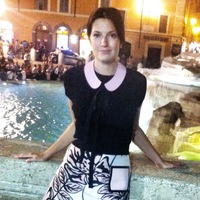Собор Святой Софии, Стамбул.
История этого храма насчитывает более тысячи лет, начиная с 4 века, на его месте неоднократно возводились церкви, но по разным причинам (пожар, землетрясения, вражеские набеги) от этих сооружений не оставалось камня на камне. В 994 году собор Святой Софии отстроили в восьмой раз, но освятили его в 537 году, именно с тогда началась его официальная история.
Возведение собора было инициировано византийским императором Юстинианом, который хотел отобразить в нем всю мощь и богатство Византии, а также сделать его олицетворением собственного величия. Над строительством храма трудились одни из лучших зодчих того времени Исидор Милетский и Анфимий Тралльский, ежедневно работало более десятка тысяч разнорабочих. Самые дорогие строительные материалы привозились изо всех уголков мира.
Так стены и даже пол сделаны из розового, зеленого, красного и белого мрамора, а переходы между ними выложены резными фризами покрытыми золотом, широко использовалась слоновая кость, всюду инкрустированы драгоценные камни, много украшений из жемчуга.
Вообще Юстиниан планировал покрыть мраморные стены золотом, но ему предрекли, что храм в будущем будет захвачен и разграблен, поэтому от своей грандиозной затеи ему пришлось отказаться. Тем не менее, на строительство храма была потрачена сумма равная двум годовым бюджетам Византийской империи. Для его постройки применялись не только неимоверно дорогие материалы, но и совершенно новые технологии, например, чтобы сделать цемент более крепким в него добавляли растительное масло, а известь разводили водой, настоянной на зернах ячменя.
Но особо выделяется купол, до этого мир еще не видел сооружения подобной конструкции, впервые применялись гнутые особым образом треугольные своды (паруса), их поддерживало четыре опоры, соединенные многочисленными арками, которые выполняли функцию окон. Благодаря этому, кажется, купол парит в невесомости, а солнечный свет излучает сам собор.
За долгие годы многие ценности (в частности золотой алтарь) были вывезены, старинные настенные фрески закрасили известью, архитектурный ансамбль дополнен минаретами, православная символика сменена мусульманской. Но, даже не смотря на это, собор Святой Софии не утратил своего великолепия и по-прежнему считается одним из величайших храмов мира.
История этого храма насчитывает более тысячи лет, начиная с 4 века, на его месте неоднократно возводились церкви, но по разным причинам (пожар, землетрясения, вражеские набеги) от этих сооружений не оставалось камня на камне. В 994 году собор Святой Софии отстроили в восьмой раз, но освятили его в 537 году, именно с тогда началась его официальная история.
Возведение собора было инициировано византийским императором Юстинианом, который хотел отобразить в нем всю мощь и богатство Византии, а также сделать его олицетворением собственного величия. Над строительством храма трудились одни из лучших зодчих того времени Исидор Милетский и Анфимий Тралльский, ежедневно работало более десятка тысяч разнорабочих. Самые дорогие строительные материалы привозились изо всех уголков мира.
Так стены и даже пол сделаны из розового, зеленого, красного и белого мрамора, а переходы между ними выложены резными фризами покрытыми золотом, широко использовалась слоновая кость, всюду инкрустированы драгоценные камни, много украшений из жемчуга.
Вообще Юстиниан планировал покрыть мраморные стены золотом, но ему предрекли, что храм в будущем будет захвачен и разграблен, поэтому от своей грандиозной затеи ему пришлось отказаться. Тем не менее, на строительство храма была потрачена сумма равная двум годовым бюджетам Византийской империи. Для его постройки применялись не только неимоверно дорогие материалы, но и совершенно новые технологии, например, чтобы сделать цемент более крепким в него добавляли растительное масло, а известь разводили водой, настоянной на зернах ячменя.
Но особо выделяется купол, до этого мир еще не видел сооружения подобной конструкции, впервые применялись гнутые особым образом треугольные своды (паруса), их поддерживало четыре опоры, соединенные многочисленными арками, которые выполняли функцию окон. Благодаря этому, кажется, купол парит в невесомости, а солнечный свет излучает сам собор.
За долгие годы многие ценности (в частности золотой алтарь) были вывезены, старинные настенные фрески закрасили известью, архитектурный ансамбль дополнен минаретами, православная символика сменена мусульманской. Но, даже не смотря на это, собор Святой Софии не утратил своего великолепия и по-прежнему считается одним из величайших храмов мира.
Hagia Sophia, Istanbul.
The history of this temple dates back more than a thousand years, starting from the 4th century, churches were repeatedly erected in its place, but for various reasons (fire, earthquakes, enemy raids) from these structures there was no stone unturned. In 994, Hagia Sophia was rebuilt for the eighth time, but it was consecrated in 537, it was then that its official history began.
The construction of the cathedral was initiated by the Byzantine emperor Justinian, who wanted to display in it all the power and wealth of Byzantium, as well as make it an embodiment of his own greatness. One of the best architects of the time, Isidore of Miletus and Anthimius of Thrall, worked on the construction of the temple; more than ten thousand laborers worked daily. The most expensive building materials were brought from all over the world.
So the walls and even the floor are made of pink, green, red and white marble, and the transitions between them are lined with carved friezes coated with gold, ivory was widely used, precious stones are encrusted everywhere, a lot of pearl jewelry.
In general, Justinian planned to cover the marble walls with gold, but he was predicted that the temple would be captured and plundered in the future, so he had to abandon his grandiose undertaking. Nevertheless, an amount equal to the two annual budgets of the Byzantine Empire was spent on the construction of the temple. For its construction, not only incredibly expensive materials were used, but also completely new technologies, for example, to make cement stronger, vegetable oil was added to it, and lime was diluted with water infused with barley grains.
But the dome stands out especially, before this the world had not yet seen constructions of a similar design, for the first time triangular arches (sails) bent in a special way were used, they were supported by four supports connected by numerous arches that served as windows. Thanks to this, it seems that the dome soars in zero gravity, and the cathedral itself radiates sunlight.
Over the years, many valuables (in particular the golden altar) were taken out, the old wall murals were painted with lime, the architectural ensemble was supplemented with minarets, Orthodox symbols were replaced by Muslim ones. But, despite this, the Hagia Sophia did not lose its splendor and is still considered one of the greatest temples in the world.
The history of this temple dates back more than a thousand years, starting from the 4th century, churches were repeatedly erected in its place, but for various reasons (fire, earthquakes, enemy raids) from these structures there was no stone unturned. In 994, Hagia Sophia was rebuilt for the eighth time, but it was consecrated in 537, it was then that its official history began.
The construction of the cathedral was initiated by the Byzantine emperor Justinian, who wanted to display in it all the power and wealth of Byzantium, as well as make it an embodiment of his own greatness. One of the best architects of the time, Isidore of Miletus and Anthimius of Thrall, worked on the construction of the temple; more than ten thousand laborers worked daily. The most expensive building materials were brought from all over the world.
So the walls and even the floor are made of pink, green, red and white marble, and the transitions between them are lined with carved friezes coated with gold, ivory was widely used, precious stones are encrusted everywhere, a lot of pearl jewelry.
In general, Justinian planned to cover the marble walls with gold, but he was predicted that the temple would be captured and plundered in the future, so he had to abandon his grandiose undertaking. Nevertheless, an amount equal to the two annual budgets of the Byzantine Empire was spent on the construction of the temple. For its construction, not only incredibly expensive materials were used, but also completely new technologies, for example, to make cement stronger, vegetable oil was added to it, and lime was diluted with water infused with barley grains.
But the dome stands out especially, before this the world had not yet seen constructions of a similar design, for the first time triangular arches (sails) bent in a special way were used, they were supported by four supports connected by numerous arches that served as windows. Thanks to this, it seems that the dome soars in zero gravity, and the cathedral itself radiates sunlight.
Over the years, many valuables (in particular the golden altar) were taken out, the old wall murals were painted with lime, the architectural ensemble was supplemented with minarets, Orthodox symbols were replaced by Muslim ones. But, despite this, the Hagia Sophia did not lose its splendor and is still considered one of the greatest temples in the world.
У записи 1 лайков,
0 репостов.
0 репостов.
Эту запись оставил(а) на своей стене Ася Касимова





















